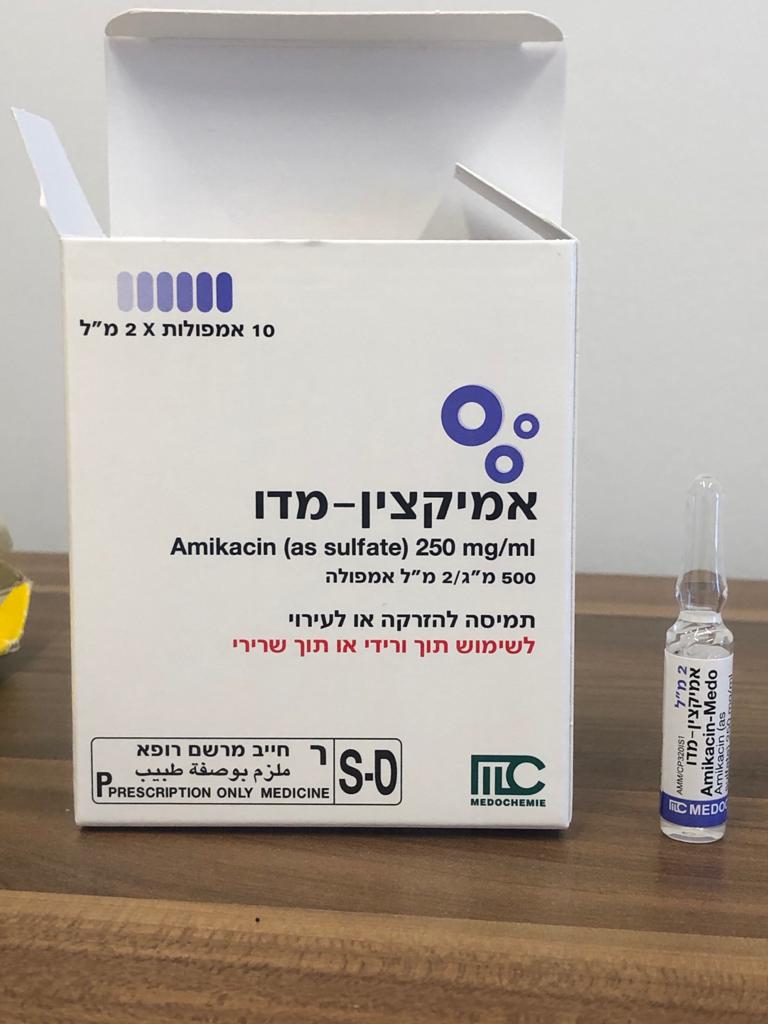Quest for the right Drug

אמיקצין-מדו AMIKACIN - MEDO (AMIKACIN AS SULFATE)
תרופה במרשם
תרופה בסל
נרקוטיקה
ציטוטוקסיקה
צורת מתן:
תוך-שרירי, תוך-ורידי : I.M, I.V
צורת מינון:
תמיסה להזרקהאינפוזיה : SOLUTION FOR INJECTION / INFUSION
עלון לרופא
מינוניםPosology התוויות
Indications תופעות לוואי
Adverse reactions התוויות נגד
Contraindications אינטראקציות
Interactions מינון יתר
Overdose הריון/הנקה
Pregnancy & Lactation אוכלוסיות מיוחדות
Special populations תכונות פרמקולוגיות
Pharmacological properties מידע רוקחי
Pharmaceutical particulars אזהרת שימוש
Special Warning עלון לרופא
Physicians Leaflet
Adverse reactions : תופעות לוואי
4.8 Undesirable effects This list is presented by system organ class, MedDRA preferred term, and frequency using the following frequency categories: very common (≥1/10), common (≥1/100, < 1/10), uncommon (≥1/1000, < 1/100), rare (≥1/10000, < 1/1000), very rare (<1/10000) and not known (cannot be estimated from the available data). Syste O ga Class F e ue y MedDRA Te I fe tio s a d I festatio s U o o Supe i fe tio s o olo isatio ith esista t a te ia o easta Blood a d l phati s ste diso de s Ra e A ae ia, eosi ophilia I u e s ste diso de s Not k o A aph la ti espo se a aph la ti ea tio , a aph la ti sho k a d a aph la toid ea tio , h pe se siti it Meta olis a d ut itio diso de s Ra e H po ag esae ia Ne ous s ste diso de s Not k o Pa al sisa Ra e T e o a, pa esthesiaa, heada he, ala e diso de a E e diso de s Ra e Bli d ess , eti al i fa tio Ea a d la i th Diso de s Ra e Ti itusa, h poa usisa Not k o Deaf essa, deaf ess eu ose so a Vas ula diso de s Ra e H pote sio Respi ato , tho a i a d ediasti al Not k o Ap oea, o hopas diso de s Gast oi testi al diso de s U o o Nausea, o iti g Ski a d su uta eous tissue diso de s U o o Rash Ra e P u itus, u ti a ia Mus uloskeletal, o e ti e tissue a d Ra e A th algia, us le t it hi ga o e diso de s Re al a d u i a diso de s Not k o Re al failu e a ute, eph opath to i , ells i u i ea Ra e Oligu iaa, lood eati i e i easeda, al u i u iaa, azote iaa, ed lood ells u i ea, hite lood ells u i ea Ge e al diso de s a d ad i ist atio Ra e P e ia site o ditio s a See se tio . . A ika i is ot fo ulated fo i ta it eal use. Bli d ess a d eti al i fa tio ha e ee epo ted follo i g i t a it eous ad i ist atio s i je tio i to the e e of a ika i . All a i ogl osides ha e the pote tial to i du e ototo i it , e al to i it , a d eu o us ula blockade. These toxicities occur more frequently in patients with renal impairment, in patients treated with other ototoxic or nephrotoxic drugs, and in patients treated for longer periods and/or with higher doses than recommended (see section 4.4) Renal function changes are usually reversible when the drug is discontinued. Toxic effects on the eighth cranial nerve can result in hearing loss, loss of balance, or both. Amikacin primarily affects auditory function. Cochlear damage includes high frequency deafness and usually occurs before clinical hearing loss can be detected by audiometric testing (see section 4.4). When the recommended precautions and dosages are followed the incidence of toxic reactions, such as tinnitus, vertigo, and partial reversible deafness, skin rash, drug fever, headache, paraesthesia, nausea and vomiting is low. Urinary signs of renal irritation (albumin, casts, and red or white cells), azotaemia and oliguria have been reported although they are rare. Reporting of suspected adverse reactions Reporting suspected adverse reactions after authorisation of the medicinal product is important. It allows continued monitoring of the benefit/risk balance of the medicinal product. Any suspected adverse events should be reported to the Ministry of Health according to the National Regulation by using an online form /https://sideeffects.health.gov.il

שימוש לפי פנקס קופ''ח כללית 1994
לא צוין
תאריך הכללה מקורי בסל
לא צוין
הגבלות
לא צוין
מידע נוסף
